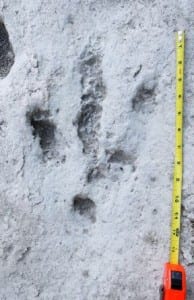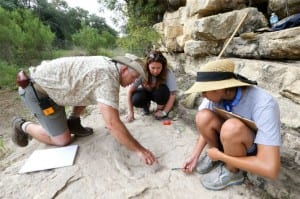SMU alum partners with Texas to preserve tracks of huge meat-eating dinosaur that roamed San Antonio 110 million years ago.
Houston Chronicle reporter Marvin Pfiefer has written about a project led by SMU alum Thomas L. Adams to catalog and protect the tracks of a 110 million-year-old dinosaur preserved in rock at Government Canyon State Natural Area. Adams, a paleontologist, is a graduate of Dedman College’s Roy M. Huffington Department of Earth Sciences.
The story, “Project to protect rare dinosaur tracks,” published in the Thursday, Aug. 28 edition of the Houston Chronicle.
Adams is curator of paleontology and geology at the Witte Museum in San Antonio, Texas.
Adams will be joined on the project by other student volunteers from surrounding colleges to team up with the Texas Parks and Wildlife Department to catalog the tracks, which were discovered about 10 years ago.
While at SMU, Adams’ contributions to the field of paleontology included making a 3-D image of Texas’ high-profile Glen Rose dinosaur footprints using portable laser scanning technology. That research was covered by Earth magazine in the 2011 article Mapping Dino Footprints in 3D.
He also identified a 96-million-year-old crocodile Terminonaris making its first appearance in Texas. It’s narrow fossil snout was discovered along the shoreline of a lake near Dallas, which was covered by London’s Daily Mail newspaper in the article Meet the 25 ft prehistoric Texas crocodile who lived 100 million years ago in 2011.
EXCERPT:
By Marvin Pfeiffer
Houston Chronicles
It walked slowly along the tidal flat, looking for something to eat that might have washed up on the shoreline. To its right were the sounds of the surf and the ancestral Gulf of Mexico. To its left was a dense forest.Acrocanthosaurus, a fearsome meat-eating dinosaur 40 feet long and 16 feet tall, was on the move.
“It’s the size of Tyrannosaurus rex — not as bulky, but as big. And here it is, walking across the beach 110 million years ago in what is now San Antonio,” said Thomas L. Adams, Ph.D., curator of paleontology and geology at the Witte Museum.
It’s a striking discovery: the only publicly known dinosaur tracks in Bexar County. Officials have known about the tracks at Government Canyon State Natural Area for about 10 years, but it wasn’t until this summer that scientists and students began work to catalog and protect them.
Dinosaur tracks might not seem to be as interesting as fossilized bones, but scientists beg to differ.
“The hard parts of the animals that are preserved are remains of dead animals,” Adams told the San Antonio Express-News. “They tell you something about a dead animal.
“This was made by a living animal. He was moving. He was interacting with his environment. It tells you many, many things. It tells you what the shape of its foot was like because in a skeleton we can’t see that. These are the remains of living animals. They tell you a story.”
The Witte is working with the Texas Parks and Wildlife Department, which manages Government Canyon, on a joint project to bring the tracks to the public. Adams and John Koepke, natural area interpreter/volunteer coordinator at Government Canyon, are heading the research.
For more information, www.smuresearch.com.
SMU is a nationally ranked private university in Dallas founded 100 years ago. Today, SMU enrolls nearly 11,000 students who benefit from the academic opportunities and international reach of seven degree-granting schools. For more information see www.smu.edu.
SMU has an uplink facility located on campus for live TV, radio, or online interviews. To speak with an SMU expert or book an SMU guest in the studio, call SMU News & Communications at 214-768-7650.



 Booming mobile-health app market needs robust FDA oversight to ensure consumer safety, confidence
Booming mobile-health app market needs robust FDA oversight to ensure consumer safety, confidence Department of Defense awards $2.6 million to SMU STEM program for minority students
Department of Defense awards $2.6 million to SMU STEM program for minority students
 Observed by Texas telescope: Light from huge explosion 12 billion years ago reaches Earth
Observed by Texas telescope: Light from huge explosion 12 billion years ago reaches Earth Low IQ students learn to read at 1st-grade level after persistent, intensive instruction
Low IQ students learn to read at 1st-grade level after persistent, intensive instruction